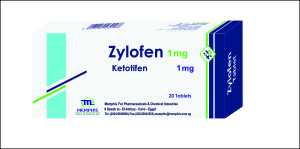TRADE NAME: ZYLOFEN TABLET. GENERIC NAME: Ketotifen fumarate COMPOSITION: Each tablet contains: Active ingredient: ketotifen fumarate 1.38 mg (equivalent to ketotifen base 1 mg) Excipients: Microcrystalline cellulose PH (Avicel), Croscarmellose sodium (Ac-Di-Sol), Magnesium stearate. PHARMACEUTICAL FORM: tablets. PHARMACOLOGICAL ACTION: PHARMACODYNAMICS: ATC code: R06AX17 Mechanism of action / pharmacodynamics Ketotifen is an anti-asthmatic agent that inhibits the effects of certain endogenous substances known to be as inflammatory mediators, thereby exerting anti-allergic activity. In vitro and in vivo laboratory experiments have shown ketotifen to show the following properties that may contribute to its activity: • Inhibiting the release of allergic mediators such as histamine and leukotrienes; • Suppression of the priming of eosinophils stimulation by human recombinant cytokines and thus inhibition of the influx of eosinophils into the inflammation loci; • Inhibition of platelet activation by the PAF (platelet activating factor) and of neural activation following exposure to an allergen. Ketotifen is an antiallergic agent with non-competitive histamine (H1) blocking properties. PHARMACOKINETICS: Absorption Ketotifen is almost completely absorbed following oral administration. Bioavailability is approximately 50% of the dose administered owing to a first pass effect of about 50%. Peak plasma concentrations are attained within 2–4 hours. Distribution Protein binding is 75%. Metabolism The main metabolite in the urine is the practically inactive ketotifen-N-glucuronide. Elimination Ketotifen is eliminated biphasically, with a short half-life of 3-5 hours and a longer one of 21 hours. About 1% of the active substance is excreted unchanged in the urine within 48 hours and 60–70% as metabolites. The pattern of metabolism in children is the same as in adults, although clearance is higher in children. Children over 3 years thus require the same daily dose as adults. Patients with hepatic impairment No relevant pharmacokinetic studies have been performed with ZYLOFEN in patients with hepatic impairment. Ketotifen is metabolized in the liver and its glucuronidation may be impaired by severe hepatic impairment. The clearance of ketotifen is likely to be reduced in patients with severe hepatic impairment and the possibility of accumulation of the unchanged drug cannot be excluded. RenaL Impairment No relevant pharmacokinetic studies have been performed with Ketotifen in patients with renal impairment. However, it must be borne in mind that 60-70% of the dose is excreted in urine as metabolites, so that an increased risk of adverse effects due to the accumulation of metabolites cannot be excluded. INDICATIONS / POSSIBLE USES Prevention and treatment of multisystemic allergic disorders: • Chronic idiopathic urticaria (e.g. cold urticaria); • Allergic rhinitis with and without concomitant asthma; • Allergic conjunctivitis; • Atopic dermatitis. It can take several weeks for ZYLOFEN to take effect. ZYLOFEN is not a substitute for corticosteroid treatment (inhaled or systemic) when corticosteroid is indicated for the treatment of asthma. DOSAGE / ADMINISTRATION: Adults The usual daily dose is 2 mg: One ZYLOFEN tablet of 1 mg twice daily (mornings and evenings) with meals. In patients susceptible to sedation, a progressive regimen is recommended during the first week of treatment: This should be started with half a standard tablet twice daily or one standard tablet in the evenings only, increasing to the full therapeutic dose over the next 5 days. If necessary, the daily dose can be increased up to 4 mg, i.e. two ZYLOFEN tablets twice daily. A more rapid onset of action can be expected with the higher dose. Children Children > 3 years of age: 1 tablet of 1 mg twice daily, (mornings and evenings). Clinical experience reflects pharmacokinetic findings and indicates that children may require a higher dose than adults (in mg / kg body weight) in order to achieve an optimal effect. Such doses are just as well tolerated as lower doses (see “Pharmacokinetics”). Concomitant use of bronchodilators: In patients treated with bronchodilators concomitantly with ZYLOFEN, it is usually possible to reduce the frequency of bronchodilator usage. Use in the elderly Experience with ZYLOFEN has shown that no special measures are necessary. Duration of treatment It may take several weeks to achieve the full therapeutic effect. It is therefore recommended that In patients who show no satisfactory response after several weeks, treatment should be continued for a minimum 2-3 months. If withdrawal of ZYLOFEN is necessary, this should be done progressively over 2-4 weeks. Symptoms of asthma may occur. CONTRAINDICATIONS: Hypersensitivity to ketotifen or any of the excipients. Epilepsy or a history of seizures (see «Warnings and precautions»). WARNINGS AND PRECAUTIONS: Convulsions have been reported during ZYLOFEN therapy. ZYLOFEN may lower the seizure threshold, and is therefore contraindicated in patients with a history of epilepsy (see “Contraindications”). There are insufficient data available on long term treatment (>4weeks) of patients with chronic idiopathic urticaria. Any corticosteroid therapy that is already being given should not be withdrawn abruptly at the start of long-term ZYLOFEN therapy. This applies particularly to systemic corticosteroids and ACTH, since there is a risk of adrenal insufficiency in steroid-dependent patients. In such cases, recovery of a normal pituitary-adrenal response to stress may take as long as one year. Specific anti-infective agents should be given in addition to ZYLOFEN to combat any intercurrent infections.
